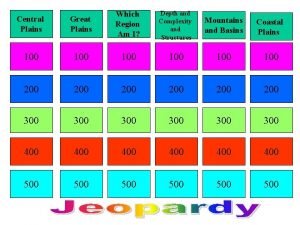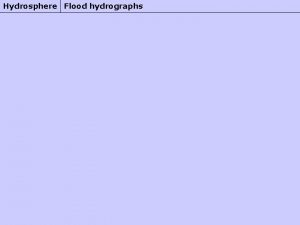Part 6 CLASSIC FLOOD PLAINS FLOOD PLAINS Flood











- Slides: 11

Part 6 CLASSIC FLOOD PLAINS

FLOOD PLAINS • Flood plains are those alluvial valleys that are periodically subject to inundation by flooding of a natural river. 75% of the sediment deposited on our continent is flood plain silt.

• Natural levees accumulate along the banks of rivers and streams that periodically flood, as sketched here.

• Upper sketch shows a typical cross section through the lower Mississippi River. Note how the channel surface is higher than the surrounding flood plain. • Lower sketch show the areal distribution of overbank flood sediments with proximity to the source channel through hydraulic sorting

• Low gradient rivers are commonly typified by extreme sinuosity, due to entropy (conservavation of energy); shown in upper figure • Flood plains adjacent to low gradient rivers are periodically subjected to inundation, as in lower figure

Flood Stage • Satellite images comparing conditions before and during the 1993 flooding of the lower Missouri River near its confluence with the Mississippi River just above St. Louis • Note the enormous land area that was inundated

Asymmetry of channel affects bank under cutting • Low gradient channels are seldom straight • Their curvature causes the channels to be over-steepened on the outer side of sharp bends, causing bank undercutting

• Low gradient channels meander to conserve energy through a process called entropy.

• Oxbows are lakes are old meander bends that are truncated and isolated when the river cuts back into its own channel, as sketched here.

Sinuous Low Gradient Stream • Oxbows and cutoffs are common features of sinuous, low gradient channels • Very treacherous to build on these

Abandoned channels • Engineering geologic map of the confluence between the Ohio and Mississippi Rivers near Cairo, Illinois • Abandoned channels are shown in blue while the active channels are white
 Central plains location
Central plains location Settling the west part 2 packet- farming the plains
Settling the west part 2 packet- farming the plains Part part whole addition
Part part whole addition Parts of a bar graph
Parts of a bar graph Unit ratio definition
Unit ratio definition The phase of the moon you see depends on ______.
The phase of the moon you see depends on ______. Brainpop ratios
Brainpop ratios Part to part variation
Part to part variation Technical description
Technical description Samantacomputer
Samantacomputer Classic metal corporation
Classic metal corporation Fashion laggers
Fashion laggers





















